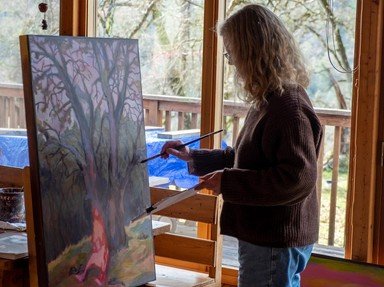Quiz Answer Key and Fun Facts
1. Van Eyck is believed to have learned his painting technique from his elder brother, Hubert van Eyck. Hubert and Jan were believed to have collaborated on the famous Ghent altarpiece (1425-1432), though recent research has discredited Hubert's involvement. The Ghent altarpiece is the subject of the first four questions of this quiz. Which scene from the New Testament (a popular one with van Eyck, who painted three versions of it) is depicted on the front wings of the altarpiece?
2. Two saints (John the Baptist and John the Evangelist) are depicted on the outer panels of the Ghent altarpiece, along with the donor and his wife. In what way does the depiction of the saints differ from that of the other two figures?
3. Which two figures from the Old Testament are depicted on the outer wings of the open Ghent altarpiece?
4. What is the subject of the bottom sections of the central section of the Ghent Altarpiece?
5. Prior the Ghent altarpiece, the van Eyck brothers were believed to have collaborated on a pair of wooden panels, completed c. 1420-1425. Which two subjects are depicted on these panels?
6. Which of these is believed to have been a self-portrait of Jan van Eyck?
7. One of van Eyck's most celebrated paintings is "The Arnolfini Betrothal". Did the artist paint a portrait of the bridegroom, Giovanni Arnolfini, in the same year?
8. There are numerous paintings of the Madonna and Child by van Eyck. One of these, which hangs in the Louvre, features an exquisitely rendered bejeweled golden crown, held above the Virgin's head by a hovering angel; which one is it?
9. One of van Eyck's finest and most characteristic works is the "Annunciation", painted c. 1434-36, which hangs in the National Gallery in Washington. In what locality does van Eyck set the Annunciation in this painting?
10. A 1439 portrait of a woman in the Stedelijk Museum voor Schone Kunsten in Bruges, Belgium, is believed by some to be of the artist's wife.
Source: Author
jouen58
This quiz was reviewed by FunTrivia editor
Bruyere before going online.
Any errors found in FunTrivia content are routinely corrected through our feedback system.
